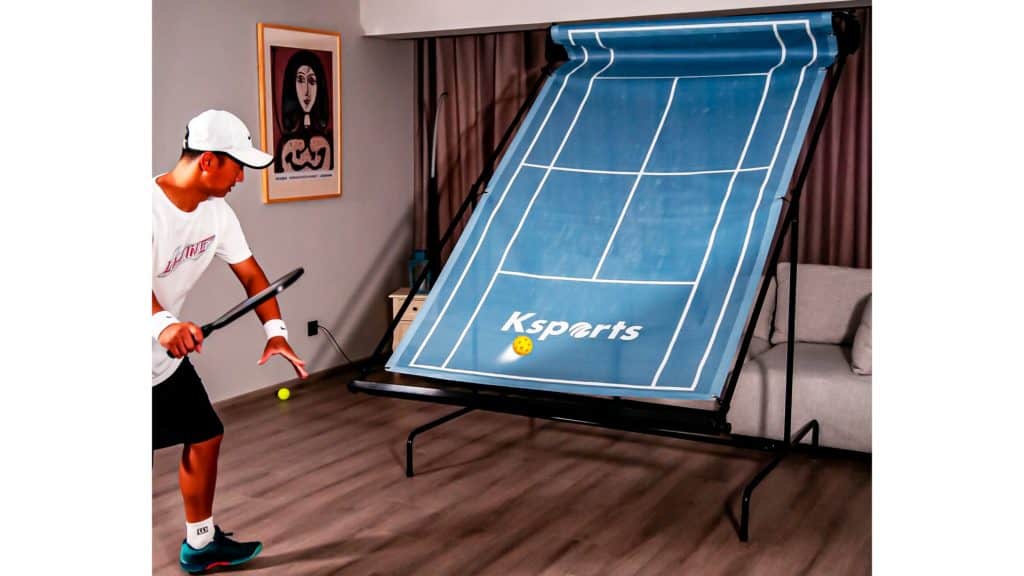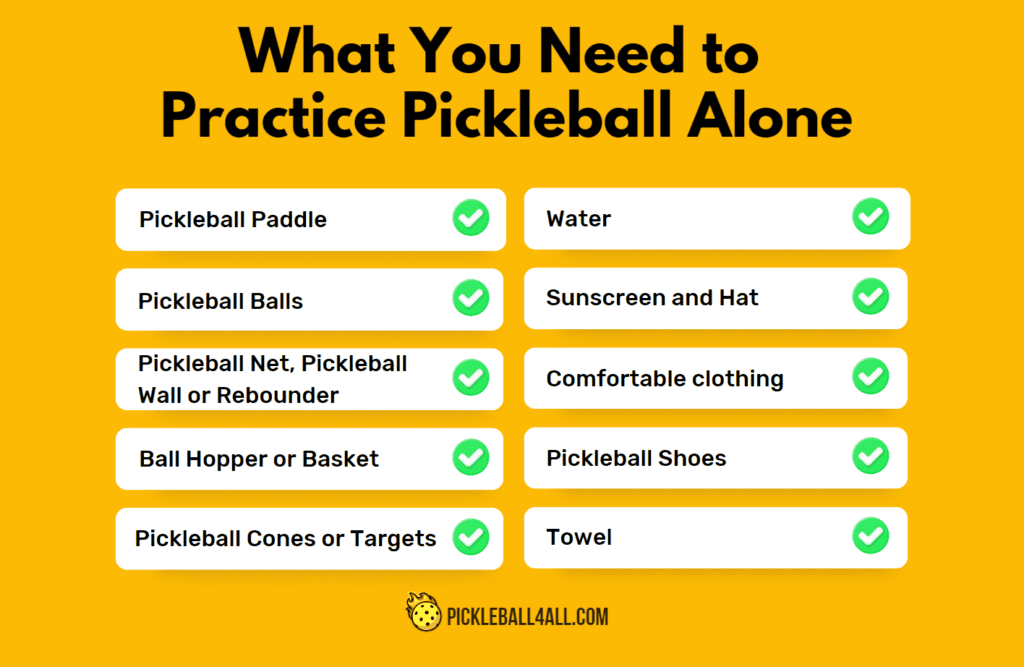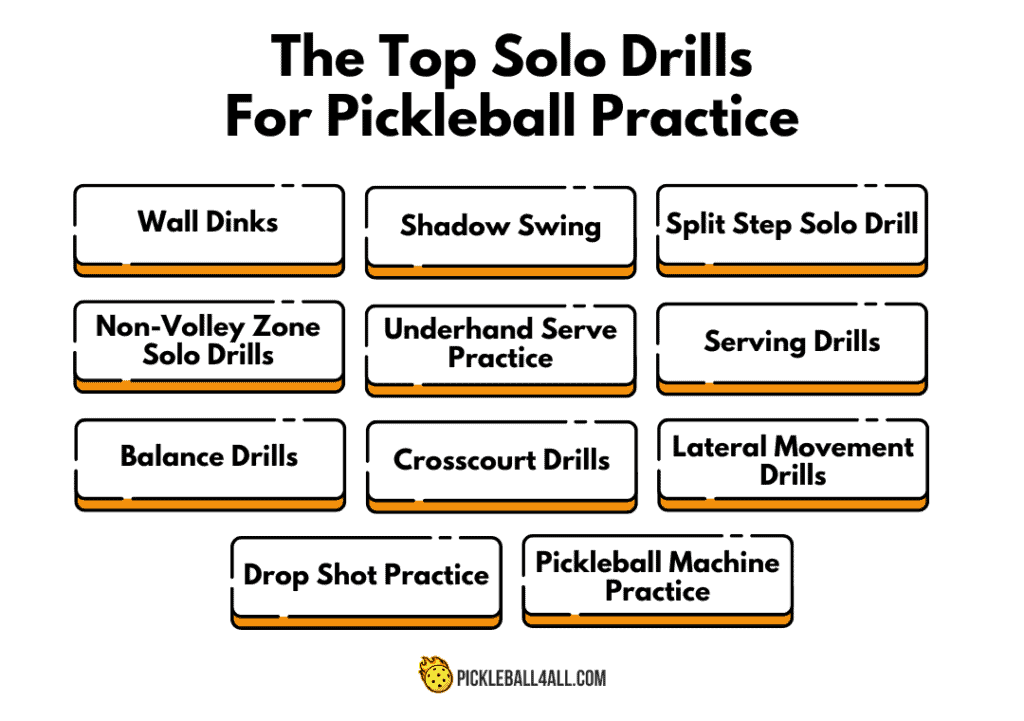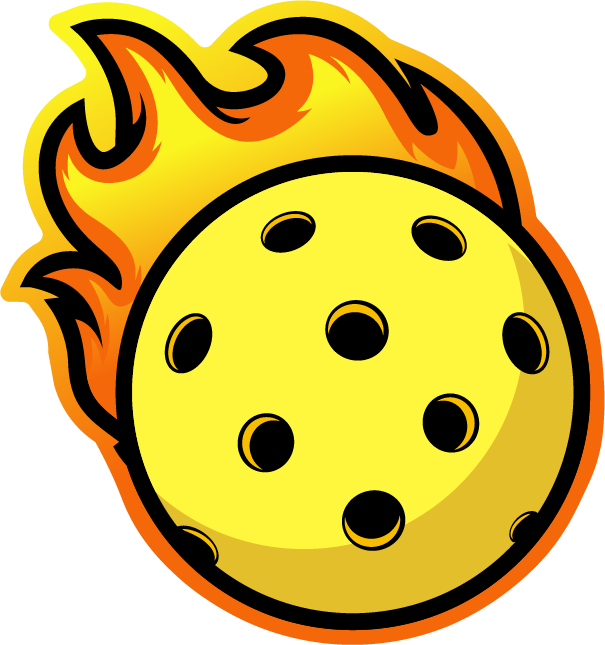Are you tired of waiting around for a partner to play pickleball? Solo pickleball practice can be a great solution! Yep, it seems like a daunting task, but it can actually be a fun and rewarding way to enhance your game.
With the right mindset, equipment, and techniques, you can transform your solo sessions into dynamic and challenging workouts. In this post, we’ll share our top strategies for practicing pickleball alone and achieving your goals.
How to Practice Pickleball Alone?
Practicing pickleball alone can be achieved using a wall or a rebounder for ball return. Focus on drills that improve serving, return shots, and dinking. You can also use a pickleball machine for consistent shots. Enhance your footwork with agility drills and improve strength with relevant exercises.

Solo Pickleball Practice: The Benefits You Don’t Want to Miss
A good practice session can be a powerful way to improve your game and build your confidence on the court.
Here are some benefits of solo pickleball practice that you don’t want to miss:
Solo Pickleball practice is recommended for:
- Those who can’t always find a partner
Players who want to improve their individual skills
Those who want to work on specific areas of their game
Pros
- Can practice anytime
- Can work on individual skills
- No need to coordinate schedules
Cons
- Limited feedback
- No competition
Practice with a Partner recommended for:
- Those who want to simulate actual game conditions
Players who want to develop their teamwork skills
Those who want feedback and competition
Pros
- Allows for game-like scenarios
- Provides social interaction
- Develops teamwork
Cons
- Need to coordinate schedules
- May not get to work on individual skills
Now that you know some of the benefits of practicing alone, let’s talk about how to stay motivated when you don’t have a partner to practice with.
How to Stay Motivated When Practicing Solo
It can be challenging to stay motivated when practicing alone, but here are some tips to help you stay focused and engaged:
By incorporating these tips into your solo practice routine, you can stay motivated and make the most out of your time on the pickleball court.
What You Need to Practice Pickleball Alone
When it comes to practicing pickleball alone, there are a few things you’ll need to get started. Here’s what you should have on hand:

The Top Solo Drills for Pickleball Practice
There are plenty of solo drills you can do to practice your skills. Here are the top solo drills that will help you improve your game:
- Wall dinks. Stand close to a wall and hit soft, gentle dinks back and forth. This will help you improve your touch, control, and finesse. Try hitting various spots on the wall to improve your accuracy.
- Shadow swing. Stand in front of a mirror in your ready position and practice your swing without hitting the ball. Focus on your form and technique, making sure to follow through on each swing. This drill will help you make your swing second nature, so you can focus on your footwork and court position during a game.
- Split step solo drill. Practice your reaction time by doing the split-step drill. Start in your ready position and jump into the air, landing with your feet shoulder-width apart. This drill will help you react quickly to your opponent’s shots.
- Non-volley zone solo drill. Practice hitting from the kitchen line to improve your control and touch. Try hitting different spots on the court and focus on keeping your shots low.
- Underhand serve practice. Use a simple mark or cone to mark the spot where you want to serve from. The practice serves and focuses on getting the ball over the pickleball net with a consistent height and speed. This solo drill will help you improve your serving accuracy and confidence.
- Serving drills. Place a target on the court and practice serving that target. Start with a larger target and gradually make it smaller as you improve.
- Balance drills. Stand on one foot and practice hitting the ball to yourself. Alternate hitting forehand and backhand shot while balancing on one foot.
- Crosscourt drills. Hit the ball crosscourt from one side of the court to the other, alternating between forehand and backhand. This will help you improve your consistency and control.
- Lateral movement drills. Practice your lateral movements by shuffling side to side along the baseline. These pickleball drills will help you improve your footwork and get into the best position to hit the ball.
- Drop shot practice. Practice dropping the ball over the pickleball net with a soft touch. Focus on hitting different spots on the court, and try to keep the ball low to make it difficult for your opponent to return.
- Pickleball machine practice. Use a pickleball machine to practice hitting consistent shots. Set the machine to hit to different spots to improve your accuracy, reaction times, and control.

Common Mistakes To Avoid When You Practice Alone
Here are the top mistakes to avoid when solo practicing:
How to Maximize Your Pickleball Solo Practice
Here are steps for maximizing your solo pickleball practice.
Step 1. Set up a solo drill station
One way to maximize your solo practice time is to set up a solo drill station. This can be done using a pickleball net, a wall, or even just a target on the ground.
Step 2. Warming Up
Before you start practicing, it’s important to warm up your body to prevent injury. A proper warm-up should include some light cardio, stretching, and practicing some simple shots.
Step 3. Use a pickleball machine
These machines allow you to practice hitting a variety of shots, including serves, groundstrokes, and volleys. They can be particularly useful for advanced players looking to take their pickleball game to the next level.
Step 4. Use solo drills and exercises
There are countless solo drills and exercises you can use to practice your pickleball skills. Some popular ones include wall drills, target practice, and shadow practice.
Step 5. Use shadow swings
Shadow swings are a great way to work on your form and technique without a ball. Advanced players can also practice hitting imaginary balls from different spots on the court.
Step 6. Use the net line to work on your drop shot technique
Stand at the nvz line and practice dropping the ball over the net and into the kitchen. This can be a challenging shot to master, but it’s an important one to have in your arsenal.
Remember to stay focused, and don’t be afraid to try new drills and techniques to challenge yourself.
How To Practice Pickleball Alone – Final Thoughts
Playing the game of pickleball is not always contingent on having an opponent. In fact, there are plenty of ways to practice pickleball alone — giving yourself a better chance at winning pickleball games in the future. For instance, with a little creativity and commitment, you can easily practice at home when you don’t have access to a pickleball or tennis court.
All you need is a racquet and a real pickleball. To start the drill, aim the ball at the wall, standing about seven feet away to mimic the distance of a pickleball game’s third shot. As a result, you can practice getting the ball back in the most optimum way.
You can also work on your dink — a slow shot intended to land in the opponent’s non-volley zone. Try holding the ball in different positions and hitting it with varying degrees of force to simulate a variety of shots coming your way during an actual game. The key is to always have the goal to hit the target.
This dedicated time to practice not only improves your overall game but also helps you get a better understanding of the dynamics of each shot. Remember, players can practice various aspects of the game even without a partner. You just need to drill solo, adopt a strategic approach, and make a conscious effort to improve your pickleball play.
The more you practice, the better pickleball player you become. Therefore, never underestimate the value of solo practice in boosting your pickleball prowess. With determination and consistent practice, you’ll soon find yourself easily handling any balls that come your way during a real pickleball game. Final thoughts? If you’re serious about your game, make time to practice — even if it’s by yourself.
So, if you’re wondering how to practice pickleball alone, just remember to focus on your technique. Be sure to try new drills and exercises, and stay committed to improving your skills. Incorporate practice serves, shadow swing, footwork drills, and targeting specific areas on the court. With time and effort, you’ll soon become a more confident pickleball player.
FAQ
How to practice pickleball at home?
There are several ways to practice pickleball at home, even if you don’t have a dedicated court. You can use a small portable net or tape to create a makeshift court in your driveway or backyard. You can also practice your serve and volleys against a wall or rebounder. Finally, you can use a ball machine or target to practice your shots and footwork.
What equipment do I need for solo pickleball practice?
The essential equipment for solo pickleball practice includes a ball machine, a target, and practice balls. You may also want to consider investing in a rebounder or a wall to practice against.
Can I improve my game by practicing alone?
Yes, it’s a great idea. Practicing alone can be a great way to improve your game. By practicing alone, you can focus on your technique, footwork, and other skills without the distraction of a partner.
How often should I practice alone?
The frequency of your solo practice will depend on your schedule and goals. However, it’s recommended to practice for at least an hour a day, several times a week.
Can practicing alone replace playing with a partner?
While practicing alone can be beneficial, it cannot fully replace playing with a partner. Playing with a partner allows you to work on your communication skills and court positioning, which are essential for doubles play.
Can I use a regular tennis ball for solo pickleball practice?
While it’s possible to use a regular tennis ball for solo pickleball practice, it’s recommended to use a pickleball-specific ball. These balls are designed to be slower and have less bounce, which is better suited for pickleball practice.
What is a pickleball practice wall?
A pickleball practice wall is a dedicated wall designed specifically for practicing pickleball. It can be made of different materials such as wood, concrete, or plastic. Also, it can have different features such as target lines, bounce-back capabilities, and adjustable angles.
How can I make a pickleball practice wall?
You can make a pickleball practice wall using materials such as plywood, cinder blocks, or concrete. There are many online resources that provide step-by-step instructions for building a pickleball practice wall, and you can also find pre-made wall systems available for purchase.
What is pickleball and how to play the pickleball game?
Pickleball is a fun and engaging sport that fuses elements of tennis, badminton, and ping-pong. It involves hitting a pickleball ball over a pickleball net using a pickleball paddle. The aim is to hit the ball to the opponent’s side of the pickleball court by serving diagonally. Scoring is done when the opponent fails to return the ball or commits a fault. The non-volley zone, also known as the kitchen line, is a crucial area where volleys are not allowed.
How can you practice pickleball alone?
If you don’t have a pickleball court or a partner, there’s only one great solution – you can practice pickleball alone. One common way to practice is by doing solo pickleball drills. One such drill involves hitting the ball against a wall or using a pickleball machine. This type of solo drill, often called the wall drill, allows you to practice your swing and practice hitting the ball effectively.
Which solo pickleball drills can help to improve my skills?
There are several solo pickleball drills you can do to enhance your pickleball skills. These include the wall drill, where you hit the ball against a wall, and the serving drill, where you aim to land the ball in specific areas of a makeshift court. Others include the volly drill, to improve your non-volley zone play, and the bounce drill to better your groundstrokes.
